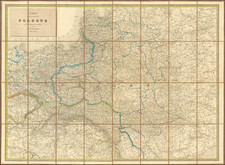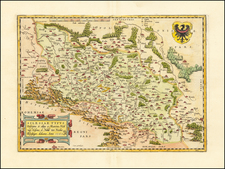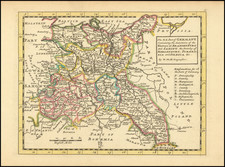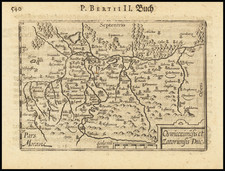An Overview of Poland's Changing Borders After the Kosciuszko Uprising
This remarkable and quite rare map offers a comprehensive geographical representation of Poland from the latter half of the 18th century. It showcases in minute detail the partitions of the Kingdom of Poland in 1772, 1793, and 1795.
The map is crafted with a level of precision that vividly illuminates the geographical attributes of the region. It encapsulates not just the territorial outlines, but also the multitude of towns and cities, each marked with meticulous accuracy.
The map is color-coded, aiding the viewer in understanding the three partitions that dismembered the once mighty Polish-Lithuanian Commonwealth. Prussia is marked in green, Russia in red, and Austria in yellow. The map thus allows a visual comparison of the territorial gains of the three powers at the expense of Poland.
The first partition in 1772 came about due to the opportunistic endeavors of these neighboring powers. Prussia, seeking a land connection between its western and eastern territories, secured Royal Prussia (excluding Gdańsk and Toruń). Russia annexed eastern parts of the Commonwealth, and Austria claimed the southern province of Galicia.
In the second partition of 1793, instigated by Russia and Prussia following Poland's unsuccessful attempt at political reform, these powers further extended their territories. Russia seized land up to the Bug River, while Prussia took Great Poland and Kuyavia.
The third and final partition in 1795 effectively erased the Polish state from the map of Europe. As a consequence of the Kosciuszko Uprising, the remaining Polish territories were divided among the three powers. Russia acquired the bulk, Austria gained Western Galicia and Southern Masovia, and Prussia received the remainder of Masovia, including Warsaw.
The Kosciuszko Uprising
Named after its leader Tadeusz Kosciuszko, the Kosciuszko Uprising was a significant rebellion in the history of Poland and Lithuania. It took place in 1794, between the second and third partitions of Poland, and it was the last major attempt by the Polish-Lithuanian Commonwealth to retain its independence.
Tadeusz Kosciuszko was a military engineer who had gained notable experience and fame in the American Revolutionary War. He returned to his homeland of Poland and assumed leadership of the resistance against the aggressive encroachments of the neighboring powers - Russia, Prussia, and Austria.
Kosciuszko's main intent was to unite the people of Poland-Lithuania, irrespective of their social class, against their common enemies. In a radical move, he sought to involve peasants in the uprising by promising them civil liberties and abolition of serfdom. He initiated the insurrection in March 1794 by making a symbolic proclamation of a universal uprising against foreign rule, famously known as the "Kosciuszko Uprising."
The uprising had some initial successes, such as the victorious Battle of Racławice where Polish peasant volunteers played a crucial role. However, the rebellion faced immense challenges, both internally and externally. The internal unity Kosciuszko sought was not fully achieved due to the deeply entrenched social hierarchies and resistance from the nobility to granting rights to the peasantry.
Externally, the combined forces of Russia and Prussia proved overwhelming. Kosciuszko was severely wounded and captured at the Battle of Maciejowice in October 1794. Soon after, the Russians brutally suppressed the Warsaw Uprising, effectively ending the Kosciuszko Uprising.
The uprising, although unsuccessful, had substantial implications. It marked a significant shift in Polish history, representing an early push towards a more egalitarian society. Its suppression led directly to the Third Partition of Poland in 1795, erasing Poland from the map for over a century until its re-establishment in 1918. Despite its failure, the uprising became a potent symbol of Polish resistance and the struggle for national independence, with Tadeusz Kosciuszko emerging as a national hero.
Rarity
The map is quite rare on the market. This is the second example we have offered in over 25 years.









![[ Southern Ukraine / Mykolaiv Oblast / Kherson ] Die Otschakowische Tartarey Oder Westliches Nogaj Auc Jedistan](https://storage.googleapis.com/raremaps/img/small/102019.jpg)


![[Krakow] Pianta di Cracovia](https://storage.googleapis.com/raremaps/img/small/66747.jpg)

